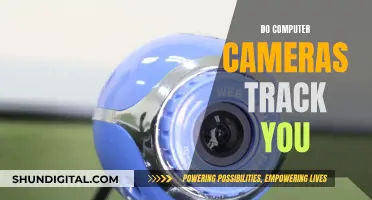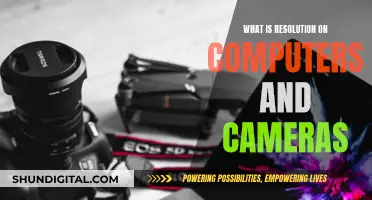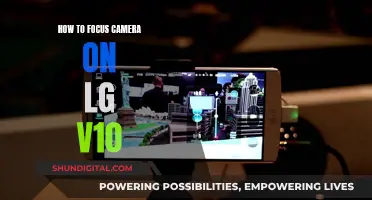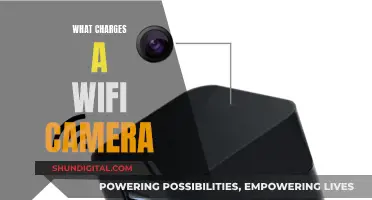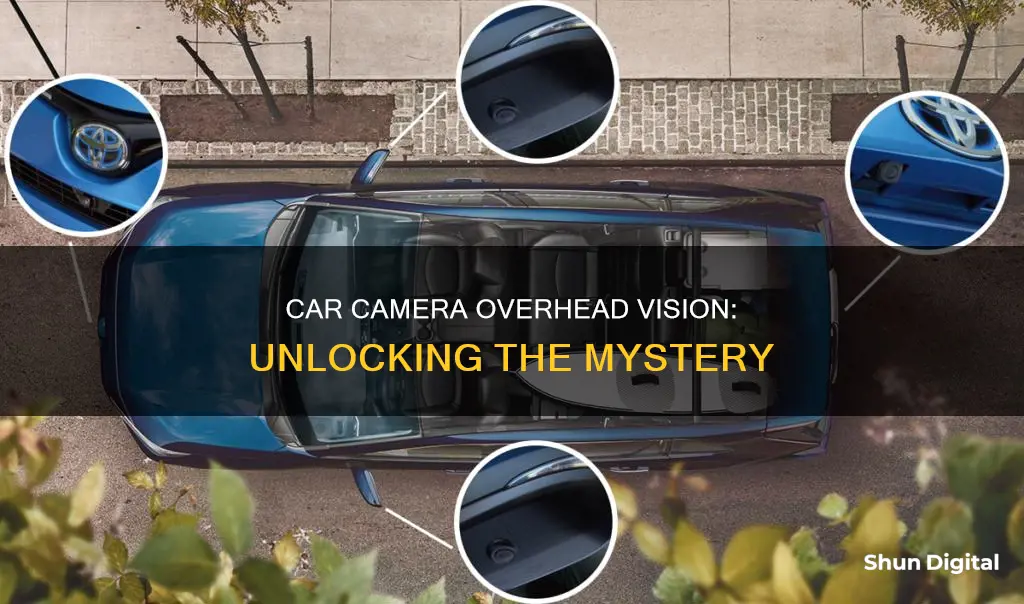
Ever wondered how car cameras can see overhead? Well, it's not quite magic, but it is an impressive combination of hardware and software. These systems, often called Bird's Eye View Cameras, use multiple cameras positioned around a car to capture images of the vehicle's perimeter. The images are then stitched together using image-processing software to create a composite, cohesive view of the car and its surroundings, which is projected onto the dashboard or infotainment system. This gives the driver a top-down view as if the car was being filmed by a drone, making parking and manoeuvring much easier.
| Characteristics | Values |
|---|---|
| Number of Cameras | 4-6 |
| Camera Placement | Front grille, under the rear-view mirrors, near the boot latch, ahead of the front wheels, and on the tail |
| Camera Lenses | Wide-angle |
| Camera Calibration | Intrinsic and extrinsic calibration |
| Image Processing | Geometric alignment, photometric alignment, and composite view synthesis |
| Display | Infotainment system screen |
What You'll Learn

Camera placement
Typically, four to six cameras with wide-angle lenses are integrated into the vehicle's body panel. Strategic locations include the front grille, under the rear-view mirrors on either side, and at the rear, often near the boot latch. Some systems also include side-view cameras positioned ahead of the front wheels, enabling drivers to see what is on the other side of obstacles.
When determining camera placement, system designers use CAD models to simulate different vehicle load configurations and analyse the field of view and blind zones from various angles. This process ensures that the cameras provide comprehensive coverage without obstructing other vehicle functions.
Another important consideration is camera calibration. No two cameras produce identical outputs, so calibration is necessary to compensate for slight differences in images due to factors such as lens placement, aging, and thermal expansion. Intrinsic and extrinsic calibration of cameras is essential for the optimal performance of the 360-degree view system.
In addition to strategic camera placement, proximity sensors are used to evaluate the distance to nearby objects. These ultrasonic or electromagnetic devices send signals that reflect off surrounding objects, providing accurate data about the distance between the car and potential obstacles. This information, combined with the visual data from the cameras, creates a comprehensive understanding of the vehicle's surroundings.
The Evolution of Smartphone Cameras: How Are They Made?
You may want to see also

Image stitching
The image stitching process typically involves the following steps:
- Image registration: This step involves detecting key points on multiple overlapping images and assigning them to a common ground plane. Custom pattern registration is commonly used in 360-degree vision systems.
- Warping: In this step, the undistorted image is deformed to match certain defined key points. Techniques such as homography, polynomial deformation, or moving least squares are applied to deform the image.
- Blending: This is where individual images are blended and merged to obtain the final stitched image. Multiband blending (for best resolution), feathering, and 50% blending are commonly used algorithms for this step.
It's important to note that image stitching for car cameras requires careful placement of the cameras. The cameras should be positioned to have a clear view of the vehicle's perimeters without disrupting the aesthetics or functionality of the car. System designers use CAD models to simulate and analyse the field of view and blind zones from different angles and vehicle load configurations.
Additionally, camera calibration is crucial to ensure optimal performance of the bird's-eye view system. Intrinsic and extrinsic calibration are performed to compensate for differences in camera output, even when cameras are mounted in the same location. Proper camera calibration ensures that output images are aligned correctly and colours are accurate.
By effectively employing image stitching techniques and considering the design aspects, car camera systems can provide drivers with a seamless 360-degree view, greatly enhancing their situational awareness and making parking and manoeuvring in tight spaces much easier.
The Rise of Surveillance Cameras: A Historical Perspective
You may want to see also

Proximity sensors
There are several types of proximity sensors available for cars, each utilising different technologies to detect objects. One common type is the inductive proximity sensor, which uses an electromagnetic field to sense nearby metal objects. This field is generated by coils of wire, known as inductors, which create a magnetic field in front of the sensor. When changes in this field are detected, the sensor activates and sends a signal. This type of sensor is often used in keyless entry systems, automatically unlocking car doors when the owner is nearby.
Another type of proximity sensor is the capacitive proximity sensor, which uses an electric field to detect objects. These sensors typically have two parallel plates separated by a dielectric material such as plastic or glass. When connected to a power source, the plates become oppositely charged, and the sensor can detect objects by measuring changes in capacitance. Capacitive sensors can detect both metallic and non-metallic objects, making them versatile for various applications.
Ultrasonic proximity sensors are also widely used in vehicles. These sensors use two transducers to send and receive ultrasonic pulses, which bounce off objects and provide information about their distance and proximity. This technology is particularly useful for detecting obstacles in front of the sensor and is often employed in parking assistance systems.
In addition to the above, laser proximity sensors offer precise object detection. These sensors emit a laser beam and detect the presence of objects through beam reflection. Placed at each corner of the car, they can accurately measure the distance to obstacles, making them ideal for small to medium-sized objects.
Enhancing Wireless Surveillance Camera Range: Tips for Better Reach
You may want to see also

Image processing
The image processing module is a crucial component of a car's 360-degree view or bird's-eye view camera system. This software takes individual images from multiple cameras positioned around the vehicle and stitches them together to create a cohesive, synthetic, but positionally accurate, top-down view of the car and its surroundings. The final image is then projected onto the infotainment system screen, providing drivers with a real-time surround view of their car.
The process of stitching together images from multiple cameras involves several steps. Firstly, geometric alignment is performed, which includes lens distortion correction and transformation of perspective. This is followed by photometric alignment, where the brightness and colour of individual camera views are matched to ensure the final image appears seamless, as if captured by a single camera. Finally, the composite view synthesis process involves actually stitching the images together.
Image registration is a critical step in the composite view synthesis process. This involves detecting key points on each image and assigning them to a common ground plane. Custom pattern registration is commonly used in 360-degree vision systems. The next step is warping, where the undistorted image is deformed to match certain defined key points. Techniques such as homography, polynomial deformation, or moving least squares are applied to deform the image.
The final step in creating the composite image is blending, where individual images are merged to obtain the final stitched image. Multiband blending, feathering, and 50% blending are commonly used algorithms for this step. The resulting image provides drivers with a comprehensive understanding of their vehicle's surroundings, making parking and manoeuvring in tight spaces much easier and safer.
Moto Mod Camera Benefits: Enhancing Your Photography Experience
You may want to see also

Displaying the output
The output of a bird's-eye view car camera system is typically displayed on the infotainment screen of the vehicle. This screen may also be referred to as an HMI (Human Machine Interface). The image displayed on the screen is a composite of the footage from multiple cameras positioned around the vehicle. The computer inside the infotainment system knows the angle, position, and field of view of each camera. It uses this information to angle and stitch together the individual inputs to create a top-down view of the car and its surroundings. This composite image is then displayed on the screen in real time, often with a split-screen view that also shows the feed from the front, rear, or side cameras.
The top-down view is synthesised to look like it was filmed by a drone hovering about 10 to 25 feet above the vehicle. The image is processed using geometric alignment, photometric alignment, and composite view synthesis algorithms. Geometric alignment includes lens distortion correction and transformation of perspective, while photometric alignment matches the brightness and colour of individual camera views to create a seamless image. The composite view synthesis process is where the actual stitching of images takes place. This typically involves image registration, warping, and blending.
In addition to the visual display, bird's-eye view camera systems may also incorporate feedback mechanisms such as audio alerts or haptic warnings to notify the driver of nearby objects. Some systems also superimpose guidelines onto the image, showing the vehicle's current orientation and expected direction of travel based on gear selection and steering-wheel angle. These on-screen guidelines can further assist the driver in manoeuvring and parking the vehicle accurately.
The bird's-eye view camera system provides drivers with a unique perspective that enhances their situational awareness. By offering a top-down view, the system enables drivers to navigate their vehicles more easily into parking spots and avoid obstacles. This technology is particularly useful when parallel parking or manoeuvring in tight spaces, as it provides a clear understanding of the vehicle's position relative to its surroundings.
Charging Enel3e Camera Battery: Alternative Methods to Try
You may want to see also
Frequently asked questions
A car camera achieves an overhead view by stitching together camera feeds from around the car. These cameras are usually located in the grille, under the side mirrors, and near the boot latch. The images are then merged to create an image that looks like it was taken from above the car.
A typical set-up for an overhead view uses four cameras, with one in the front, two under the side mirrors, and one at the rear. However, some systems may use up to six cameras, with additional side-view cameras positioned ahead of the front wheels.
The primary purpose of an overhead view camera system is to assist with parking and manoeuvring in tight spaces. It provides a top-down view of the vehicle and its surroundings, making it easier for drivers to navigate into a parking spot and avoid obstacles.
The computer inside the infotainment system knows the angle, position, and field of view of each camera. It takes the footage, angles it appropriately, and stitches it together to create a "top-down" view. This process involves geometric alignment, photometric alignment, and composite view synthesis algorithms.


